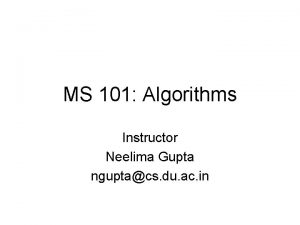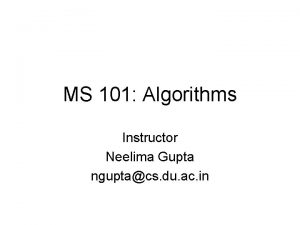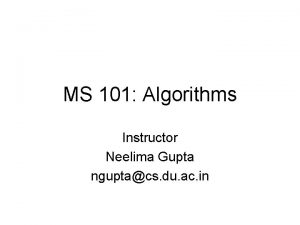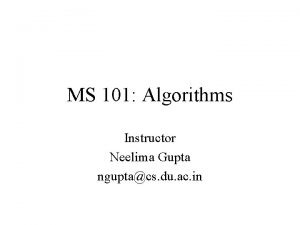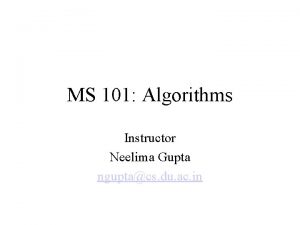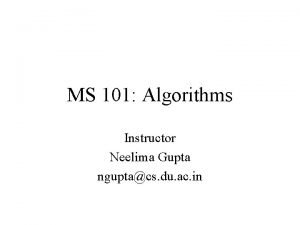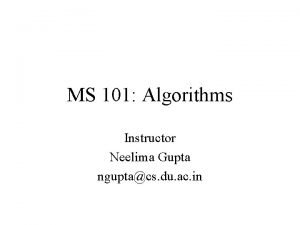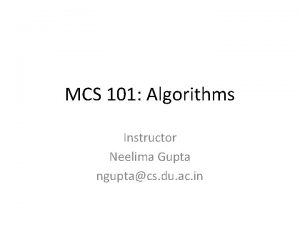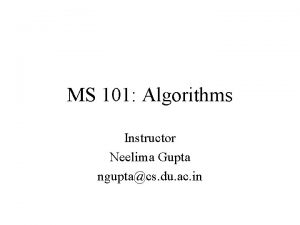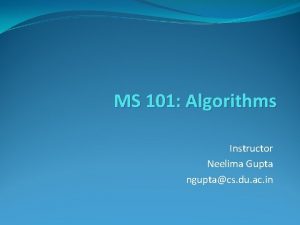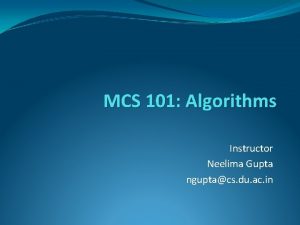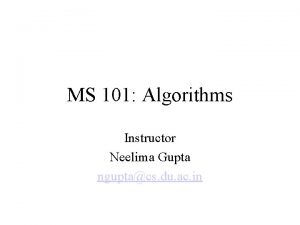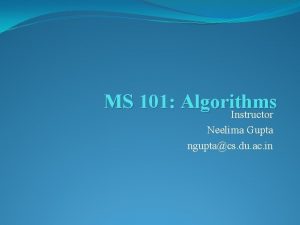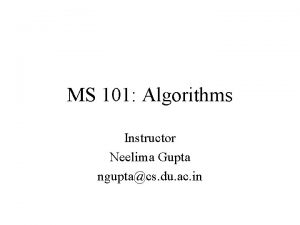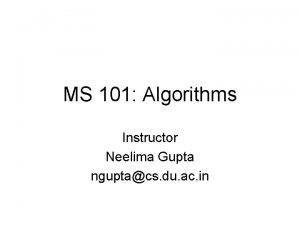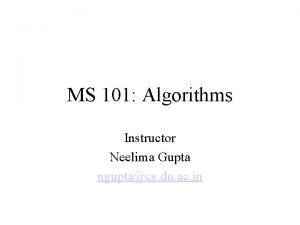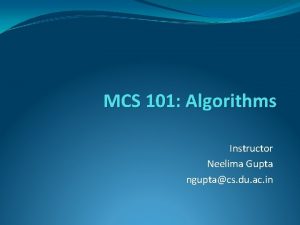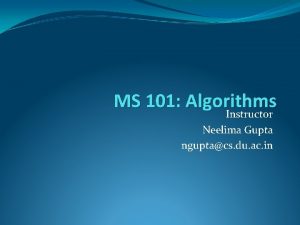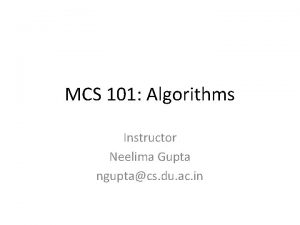MS 101 Algorithms Instructor Neelima Gupta nguptacs du






















- Slides: 22

MS 101: Algorithms Instructor Neelima Gupta ngupta@cs. du. ac. in

Table of Contents Five representative problems

Five Representative Problems Interval Scheduling : can be solved by a greedy approach. Weighted Interval Scheduling : Natural greedy doesn’t work, no other greedy is known, more sophisticated technique DP solves the problem. Maximum Bipartite Matching Independent Set Competitive Facility Location

Interval Scheduling Problem P(1)=10 P(2)=3 P(3)=4 P(4)=20 P(5)=2 0 1 2 3 4 5 6 7 Thanks to Neha (16) 8 9 Time

Examples Jobs submitted to an operating system, Resource: CPU. An HR of a company needs to schedule meetings of some committees in a meeting room, resource is meeting room Scheduling classes in a room, resource is class-room

Greedy Approach : Increasing Finishing Times P(1)=10 P(2)=3 P(3)=4 P(4)=20 P(5)=2 0 1 2 3 4 5 6 7 8 9 Time . Thanks to Neha (16) back

Weighted Interval Scheduling P(1)=10 P(2)=3 P(3)=4 P(4)=20 P(5)=2 0 1 2 3 4 5 6 7 Thanks to Neha (16) 8 9 Time

Examples Jobs submitted to an operating system, Resource: CPU. Weights: profit by executing the job

Greedy Approach P(1)=10 P(2)=3 P(3)=4 P(4)=20 P(5)=2 0 1 2 3 4 5 6 7 . Thanks to Neha (16) 8 9 Time

Greedy does not work P(1)=10 P(2)=3 Optimal schedule P(3)=4 P(4)=20 P(5)=2 Schedule chosen by greedy app Time 7 2 3 4 5 6 8 9 Greedy approach takes job 2, 3 and 5 as best schedule and makes profit of 7. While optimal schedule is job 1 and job 4 making profit of 30 (10+20). Hence greedy will not work 0 1 Thanks to Neha (16)

Example of a Bipartite graph : u 1 v 1 u 2 v 2 u 3 v 3 u 2 u 4 V 1 V 2 Figur e 1 Edge like this is not acceptable in Bipartite Graph (Thanks to Aditya(04), Abhishek(03)-Msc 2014)

Examples There is a set T of teachers with a set C of courses. A teacher can teach only some set of courses represented by the edges in the bipartite graph. Thus, bipartite graphs are used to represent relationships between two distinct sets of objects…teachers and courses here. Jobs/Employers and Applicants: An employer receives several applications but only few of them qualify for the interview. Similarly an applicant applies for many jobs but qualify only for few for them for interview. An edge (a, e) in the bipartite graph represents that the applicant ‘a’ qualifies for the interview for job ‘e’.

Maximum Bipartite Matching Problem Maximum Matching is a matching of maximum Cardinality. u 1 v 1 u 2 v 2 By Applying the definition of matching, If we choose the edge (u 1, v 1) first And then (u 2, v 2) So no more edge can be included, hence matching in this case is : u 3 v 3 (u 1, v 1) , (u 2, v 2) u 4 V 1 V 2 (Thanks to Aditya(04), Abhishek(03)-Msc 2014)

u 1 v 1 u 2 v 2 But instead of picking (u 2, v 2) , if we pick • (u 2 , v 3) after (u 1 , v 1) then • ( u 4 , v 2). u 3 v 3 Hence the Maximum Matching is : u 4 (u 1, v 1) , (u 2, v 3 ) , (u 4 , v 2) V V 2 1 So, the problem is to find the Matching with MAXIMUM CARDINALITY in a given Bipartite graph. (Thanks to Aditya(04), Abhishek(03)-Msc 2014)

Examples There is a set T of teachers with a set C of courses. A teacher can teach only some set of courses represented by the edges in the bipartite graph. A teacher needs to be assigned at most one course and one course must be taught by only one teacher. Suppose a number of committee meetings are to be scheduled in various meeting rooms during the time 3 pm 4 pm. A committee meeting can be held only in few rooms (may be because other rooms are smaller in size than the committee size etc). An edge (c, r) represents that committee ‘c’ can be scheduled in room ‘r’. A committee needs to be assigned one room and one room must be assigned to only one committee.

Maximum Bipartite Matching from Abhishek Aditya

Maximum Bipartite Matching from Abhishek Aditya

Maximum Bipartite Matching from Abhishek Aditya

Independent Set Given a graph G = (V, E), a subset S of V is said to be independent if no two nodes in S are joined by an edge in G.

Maximal Independent set of size 2 Thanks to: Sonia Verma (25, MCS '09)

Maximal Independent set of size 3 …also Maximum Thanks to: Sonia Verma (25, MCS '09)

More on Independent Set and Comp. FLP from Anurag
 Neelima gupta delhi university
Neelima gupta delhi university Clinux
Clinux Junagadh rock inscription
Junagadh rock inscription Tcole 1014 basic instructor course
Tcole 1014 basic instructor course Basic instructor course texas
Basic instructor course texas Basic instructor course #1014
Basic instructor course #1014 Basic instructor course #1014
Basic instructor course #1014 Cbrf registry wi
Cbrf registry wi Catia instructor
Catia instructor Tcole advanced instructor course
Tcole advanced instructor course Cisco certified instructor
Cisco certified instructor Ames room illusion
Ames room illusion Marksmanship instructor
Marksmanship instructor Tipo de participantes
Tipo de participantes Nfpa 1403 instructor to student ratio
Nfpa 1403 instructor to student ratio Virtual instructor art
Virtual instructor art Delmar cengage learning instructor resources
Delmar cengage learning instructor resources Nra certified instructor logo
Nra certified instructor logo Pepperball launcher nomenclature
Pepperball launcher nomenclature Instructor
Instructor Acr medical term
Acr medical term Mptc instructor
Mptc instructor Nrp instructor toolkit
Nrp instructor toolkit
